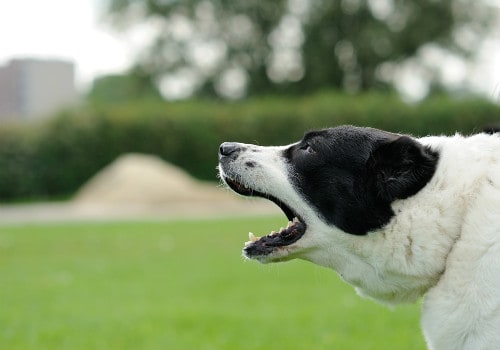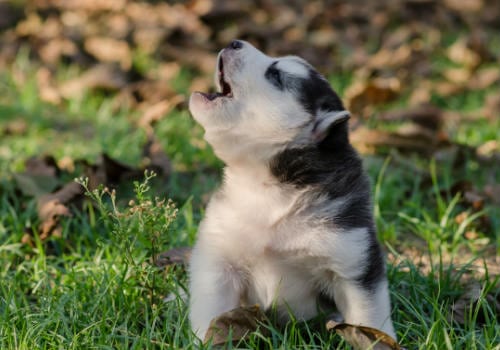Anyone who says dogs can’t talk has never owned a dog!
OK, maybe they don’t speak the way we humans do, but there’s no denying how many unique sounds dogs can produce.
And at times, they certainly seem to follow patterns similar to our own speech: different sounds are produced in response to different audiences, emotions, and situations.
To top it off, many dog breeds have their own special sounds that aren’t produced by other breeds. It’s impossible not to draw parallels to humans and our numerous spoken languages.
But we haven’t developed Google Translate for dogs (well, not yet, anyway). And it’s not always easy to figure out why your dog is making that noise — or what he’s trying to communicate with it.
Don’t worry: we’ve put together a little dog-to-human dictionary, where you can identify those strange canine sounds and figure out what they mean. Who says reading the dictionary is boring and pointless?
The Dog Sound Dictionary

Barking
Ah, the classic dog noise! Dogs wouldn’t be dogs without this signature sound, which differs across breeds and carries a host of meanings.
Depending on your dog’s voice, a bark could sound like “bark!”… or “arf!”… or “woof!”… or “ruff!”… or many other loose transcriptions. But you’ll know it when you hear it: it’s your dog’s go-to sound for all kinds of situations.
You’ll hear the bark when someone rings your doorbell, when a neighbor dog walks past your house, when a strange noise goes thump in the night and when you get home from work.
It can be happy, excited, alert, anxious, angry, needy, fearful, aggressive or just about anything else.
So how do you figure out what it means?
To decipher this dog sound, you’ll need to get to know your dog and his body language. In fact, most of a dog’s communication is carried out through body language, so it’ll provide many contextual clues to how he’s feeling.
Is your dog barking when he’s out in the yard and a new neighbor walks by? Check for a wagging tail, a relaxed stance and a bouncy gait to indicate excitement — or a tensed-up posture, flattened ears and stiff tail to indicate apprehension and defensiveness.
What about when the doorbell rings and your dog starts barking his head off?
If he heads over to the door with his tail wagging and a curious expression, chances are he’s intrigued by the newcomer. But if he stays where he is and becomes still as a statue, he’s probably afraid.
Once you understand these body language cues, deciphering dog barks become a lot simpler. But there are also clues hidden in the bark itself if you know to look for them.
One or two barks in a row could just be reflexive reactions to many different stimuli. They’re often used as greetings or as invitations to play.
Alarm barks generally occur in groups of two to four barks. Longer strings of barks indicate a more urgent or dangerous threat.
Bark tone varies depending on the size of the dog, but every dog has different bark pitches that mean different things. Higher-pitched barks usually indicate positive emotions like excitement and joy, while lower-pitched ones are more aggressive or cautionary in nature.
Howling

It seems like anything could provoke your dog to howl. He may do it when he hears a fire truck siren, when you leave for work or when the dog down the street starts howling at the moon.
Loud, sustained and almost mournful-sounding, the howl is still quite poorly understood by science. We know that wolves howl to communicate with each other and that they often do so in chorus with the whole pack, but beyond that, we know little about why they howl.
Since we live so closely with dogs, we know a little more about what causes them to howl.
In some cases, like when they’re left alone for the day, dogs howl to express sadness or anxiety. Perhaps it’s a way of getting the attention that’s difficult to ignore, or maybe it’s just uncontrollable the way human sobbing often is.
High-pitched noises, like sirens, also seem to spark howling sessions easily.
In these cases, howling may be an expression of aural pain — dog ears are very sensitive, so the discomfort we feel upon hearing such noises is likely exponentially worse for dogs.
Another theory suggests that dogs think that sirens are the howls of distant dogs, so they respond in kind.
Whatever the cause, howling is definitely a group activity for dogs, suggesting that it might be similar to singing for humans. If you hear one dog howling, expect more to join in before long — and good luck getting them to pipe down!
Sighing and Groaning
These two subdued sounds often mean the same thing, so we’ve grouped them together. They sound much like their human counterparts: the breathy sigh is a loud exhale through the nose, and the low groan rumbles in the throat and chest.
We sigh when we’re disappointed or relaxed, and dogs do the same.
You’ll hear your dog sigh when you respectfully decline a game of fetch or a walk, but you’ll also hear it after a long day at the dog park when you both finally crash on the couch.
It’s much the same with groaning, which can be positive or negative depending on the circumstances.
A positive groan could come during a particularly relaxing petting session, while a negative groan could come when you scrape your leftovers into the garbage rather than the dog bowl.
Though these sounds are relatively quiet, they’re among the most dramatic sounds a dog can make. It can seem like they’re hamming it up, but groans and sighs actually reveal the depth and nuance of a dog’s emotions like few other noises do.
Whining

Squeaky, high-pitched and ubiquitous among dogs, the whine is nearly as versatile as the bark. It can indicate excitement, anxiety, need, sadness, and even pain.
As with barking, the key to deciphering the whine is to analyze the situation and the dog’s body language.
Does your dog whine when you pick up the leash and position himself by the door, tail wagging and unable to stand still? Then it’s a whine of anticipation and excitement at getting to go for a walk.
Maybe the whining starts up while you’re at the dinner table, eating your steak and trying to ignore the begging dog sitting at your side, tail thumping the floor rapidly. That’s a needy whine, most often heard when something tasty is just out of reach.
Or does your dog whine and stare wistfully out the window when you leave the house? That indicates sadness, anxiety, and loneliness, like crying or weeping does in humans.
Growling
We seem to instinctively know that a growling dog means business. The low, sustained rumble serves as a warning: “I’m not happy, back off or face the consequences!”
And the longer the growl, the more serious the dog is about holding his ground.
But dogs also growl when they’re playing with us or with other dogs, so there are some seriously mixed signals inherent to this noise. What’s the deal?
Dogs growl when they feel threatened, afraid, angry or otherwise upset. If you’re petting your dog uncomfortably or approaching him while he’s enjoying some alone time, he might growl at you to get you to back off.
Playful growling is similar to the roughhousing, play-fighting and mouthing that takes place between dogs. It’s a less-aggressive, lighthearted, fun version of behaviors that are otherwise negative.
It’s usually pretty obvious when growling is playful, not aggressive. The dog will be actively playing and the growl will usually be higher-pitched, accompanied by open body language and an otherwise happy demeanor.
But if playtime goes too far, play-growling can turn to real growling as a warning to take it down a notch. You’ll usually be able to tell: your dog will stop playing, stop wagging his tail and stiffen his body, staring the rowdy playmate down while growling.
